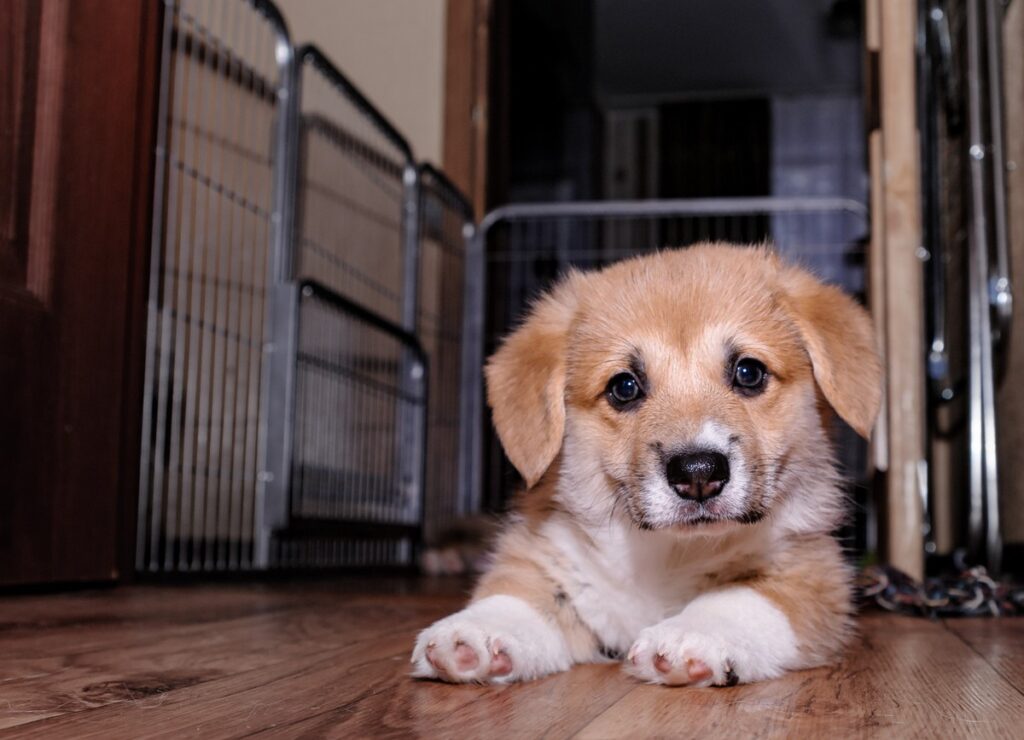A crate will be their bolt hole where they can retreat to when they wish to relax and sleep. It will also provide you with some peace of mind that your new arrival is safe and secure if you need to leave them alone for a short period. Allowing the puppy to get used to their crate or safe space also helps should they need to be crated due to illness, injury, or times of stress when they need to be kept calm and safe.
The benefits of using a crate
- Homebase or safe space for your puppy to feel secure in
- Safe and secure place if you do need to leave your puppy for a short time
- ‘Puppy only’ space when they need time to rest especially if you have a busy household or young children
- Secure space if your puppy needs to rest after illness or injury
- Comforting place during times of stress like fireworks and noisy events
Selecting the right size crate for your dog
Obviously your puppy is going to grow quite rapidly. This is worth bearing in mind when purchasing a crate, as they can be quite expensive. When your pup reaches fully grown size they will need to be able to stand, turn around and stretch comfortably within their crate.
We can refer you to the breed information as in many cases this could mean quite a large crate!
If you are unsure, we suggest that you ask for advice from your vet practice or your local pet retail shop. Have a look at our domain4pets directories to find services near you.

Where to place the crate in your home
Ideally your puppy’s crate should be situated away from extremes of temperature like radiators, full sun light and cold drafts. Away from the general hustle and bustle and high traffic areas where they could be overly disturbed.
Getting your puppy used to their crate
Make the space comfortable and cosy, use soft bedding, toys that are interesting and most importantly safe. Add some chews which will entertain and help with any tooth pain. You need to make the space enticing and somewhere they feel secure. Ensure that they also have fresh, clean water.
You could also consider a blanket to partially cover the crate for extra privacy and security during the day.
When they first venture inside, allow them to come and go as they please, sit with them and make encouraging noises and praise when they settle.
During the early stages make the duration of crate training short and sweet.
Once your pup has gained confidence entering and exiting the crate, you can start to close the door but not on the catch. You will eventually be able to fully close the crate and they will not feel anxious.
Make the crate part of your daily routine
Dogs love routine; it helps them feel safe and secure. If you incorporate the crate into your daily routine it will just become the norm. You can encourage them to relax inside with a view to closing the door. This should only be done when your puppy is relaxing either lying or sitting.
You should not leave your puppy in their crate for more than a few hours at a time to begin with.
What if your puppy dislikes the crate, barks or shows distress
You should try and establish whether they are distressed or just frustrated at being confined. Obviously, if they are anxious you should let them out and go back to the training after a break. If distressed ensure that the crate is near to you. At night you could move it closer to your bedroom as this may help them settle. Many allow their pups to sleep with them in the first few weeks, the choice is yours.
What if your puppy dislikes the crate, barks or shows distress
Sometimes, no matter how patient you are or how much positive reinforcement you give, for some puppies crates are just not going to work. There are other alternatives you can try which will offer a similar experience of safety and rest for your pup such as baby gates. These can be placed across doorways enabling the puppy to have the run of a room like the kitchen or utility room. We wish you good luck with your training! Get in touch if you have any questions or would like further advice from our experts.







